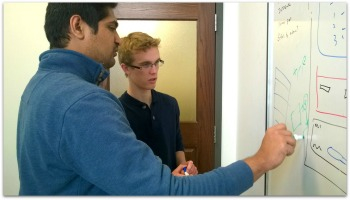
Hariharan Arunachalam's defense will be Tuesday, April 12 at 3:30 p.m. in 108 Avery. Justin Firestone's defense will be Wednesday, April 13 at 11:00 a.m. in 103-104 Avery.
Hariharan Arunachalam's Abstract:
Towards Building an Intelligent Integrated Multi-Mode Time Diary Survey Framework
Surveys have been used to quantitatively measure the perceptions of society and need to provide a sense of opinion of the target population and thus, enabling true responses is an important characteristic in surveys; where the responses are free from bias, satisficing, and different forms of deception and socially desirable responding. In this thesis, we examine the current state of surveys, briefly touching upon questionnaire surveys, and then on time diary surveys (TDS). TDS are essentially conversational surveys that are open-ended and of a free-form nature with both, the interviewer and the respondent, playing a part in its progress and successful completion. With limited research available on how intelligent and assistive components can affect time diary survey respondents, we explore the ways in which intelligent systems such as Computer Adaptive Testing, Intelligent Tutoring Systems, Recommender Systems, and Decision Support Systems can be leveraged for use in TDS. The motivation for this work is derived from realizing the opportunity that an enhanced web based instrument can offer the survey domain. Training interviewers to keep up with an increasing respondent pool increases the base cost of conducting surveys due to the time required to train interviewers and the subsequent running cost for each interview. This brings about the opportunity to unite the various facets of web based surveys to create an intelligent integrated multi-mode time diary survey framework and we envision the framework to provide all the advantages of web based surveys and interviewer assisted surveys so as to gain better foothold as a survey delivery method. The two primary challenges are in determining what data is to be used by the system and how to interact with the user – specifically integrating the (1) Interviewer-assisted mode, and (2) Self-administered mode. Our proposed solution – the intelligent integrated multi-mode framework – is essentially the solution to a set of modeling problems and we propose two sets of overreaching mechanisms: (1) Knowledge Engineering Mechanisms (KEM), and (2) Interaction Mechanisms (IxM), where KEM serves the purpose of understanding what data can be created, used and stored while IxM deals with the process of interacting with the user. We build and study a prototype instrument in the interviewer-assisted mode based on the framework. We are able to determine that the instrument improves the interview process as intended and increases the data quality of the response data collected and is able to assist the interviewer. We also observe that the framework’s mechanisms contribute towards reducing the interviewers’ cognitive load, data entry times and the interview time. Predicting the next activity provided assistance to the interviewers promoting faster data entry while providing us with elicited knowledge on how the interviewers conduct the interviews and exemplifies the framework’s flexibility and ease of modification.
-------------------------------------------------
Justin Firestone's Abstract:
A Roadmap to Safe and Reliable Engineered Biological Nano-Communication Networks
Synthetic biology has the potential to benefit society with novel applications that can improve soil quality, develop new biofuels, grow customized biological tissue, perform intelligent drug delivery, or many other possibilities. Engineers are creating techniques to program living cells, inserting new logic, and leveraging cell-to-cell communication, which result in changes to a cell's core functionality. Using these techniques, we can now create synthetic biological organisms (SBOs) with entirely new (potentially unseen) behaviors. SBOs are programmable evolving entities, and can be likened to self-adaptive programs that read inputs, process them, and produce outputs, reacting differently to different environmental conditions. With the increasing complexity of potential programs for SBOs, as in any new technology, there will be both beneficial as well as malicious uses. Although there has been much discussion about the potential safety and security risks associated with SBOs, and some research on predicting whether engineered life will be harmful, there has been little research on how to validate or verify SBOs as safe for general use.
In this thesis, we lay some foundations for a future where we can assure and validate the safety of SBOs. We first present two case studies which give insight into how difficult it will be to determine whether novel SBOs will be harmful given the large combinatorial search space available for their engineering. Second, we explain how the current U.S. regulatory environment is fragmented with respect to the multiple dimensions of SBOs. Finally, we present a way forward for formalizing the architecture of SBOs, and detail a case study to show how we may be able to utilize assurance cases to reason about SBO safety.